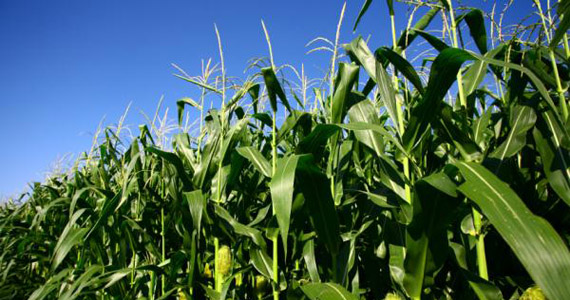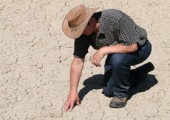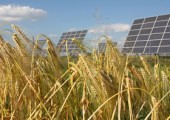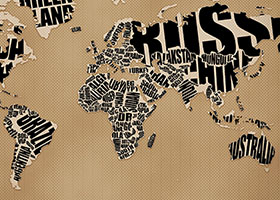It’s food security, stupid
Author | Leon Gettler
Sustainability and food security are now inextricably linked.
With big chunks of the land surface becoming uninhabitable and unavailable for agricultural production in the space of a few decades, global warming could induce food emergencies the world over.
At the same time, concerns are being raised about coal seam gas mining and the potential impacts that this industry will have on water security. Here’s the rub: with a growing population, we will have to produce more food on less land and more unstable weather patterns.
We need solid urban planning to integrate the different objectives, and ensure we have enough food.
First, we are left wondering whether it means the end of pasta. Newsweek reports that three grains – wheat, corn and rice – account for most of the food humans consume. All three are already suffering from climate change, but wheat stands to fare the worst in the years ahead. It’s the grain most vulnerable to high temperatures.
“By 2050, scientists project, the world’s leading wheat belts – the US and Canadian midwest, northern China, India, Russia, and Australia – on average will experience, every other year, a hotter summer than the hottest summer now on record. Wheat production in that period could decline between 23 and 27 per cent,” reports the International Food Policy Research Institute, “unless swift action is taken to limit temperature rise and develop crop varieties that can tolerate a hotter world.”
The Guardian reports that the United Nation is now warning that world grain reserves are so low that severe weather in the United States and other food exporting countries could trigger food shortages. The United Nations is saying that prices of main food crops such as wheat and maize are now close to those that sparked riots in 25 countries in 2008.
The UN Food and Agriculture Organisation has warned that 870 million people are malnourished and the food crisis is growing in the Middle East and Africa. Wheat production this year is expected to be 5.2 per cent below 2011, with yields of most other crops, except rice, also falling. That will send prices soaring.
“We’ve not been producing as much as we are consuming,’’ said Abdolreza Abbassian, a senior FAO economist. “That is why stocks are being run down. Supplies are now very tight across the world and reserves are at a very low level, leaving no room for unexpected events next year.”
All this coincides with NASA scientists finding that extreme summer heats are now more routine and are likely to be linked to global warming.
But global warming is only one factor. It’s a perfect storm. In his book The Coming Famine, Julian Cribb puts it down to several factors: scarcities of water, good land, energy, nutrients, technology, fish combined with population growth, consumer demand and protectionist trade policies. The increasingly unstable climates are added to the mix and that, he says, makes finding a solution all the more difficult.
“The coming famine is also complex, because it is driven not by one or two, or even half a dozen factors but rather by the confluence of many large and profoundly intractable causes that tend to amplify one another,” Cribb writes. “This means that it cannot be easily remedied by ‘silver bullets’ in the form of technology, subsidies, or single-country policy changes, because of the synergetic character of the things that power it.”
Australia is a food exporting nation but according to the Australian Institute of Family Studies, indigenous people, the unemployed, single parent households, low-income earners, rental households and young people all suffer food insecurity.
Coal seam gas and unreal choices
But the bigger issue here is the scramble for natural resources, which is creating unreal choices between food security or energy security. The coal seam gas industry is a case in point. Coal seam gas is a form of “natural gas”. About 80 per cent of it is methane. It is turned into liquefied natural gas (LNG) for export.
In his book What The Frack, journalist Paddy Manning looks at the new $50 billion industry that has created battlegrounds around Australia: grazing country, cropping country, state forest, water catchment areas, rural-residential and even urban areas. Nowhere appears to be off limits for it.
Manning says that the CSG industry is advancing steadily with support of both parties, despite voters, or at least those in Queensland, saying the industry should be stopped.
“It is a stark illustration, if another was needed, of the grip on power the fossil fuel industry has in this country. How gutless most of our politicians really are,” he says.
At the same time, there are strong economic drivers. Within five years, Australia will overtake Qatar and become the world’s biggest exporter of LNG with the mining boom coming to an end. In 2010-11, Australia sold about 20 million tonnes of LNG worth about $10 billion, making it our seventh largest export. That’s expected to rise to $60 billion by 2017-18. By 2020, earnings will rival coal revenues and make Australia less dependent on coal.
All this would fixate the minds in Canberra with the mining boom coming to an end. The government would be looking to anything to offset the collapse in commodity prices affecting living standards in Australia.
And it also wants to boost its tax revenues. Citi estimates that the corporate tax take from established LNG projects will rise from $4 billion to $13 billion by 2020, representing a 12 per cent increase in the nation’s company tax take. And state governments would be looking to get money from coal seam gas companies. Queensland Government forecasts have royalties from coal seam gas increasing from $120 million in 2014-15 to a whopping $985 million in 2031-32. For cash strapped governments everywhere, coal seam gas is a nice little earner.
But at what cost? Fracking kills fish and releases chemicals like benzene, toluene, ethylbenzene, carcinogens and radioactive isotopes into aquifers. That’s why the industry has farmers up in arms.
Even the Country Women’s Association has, for the first time, joined the demonstrators. Australia is the world’s driest continent and our farmers are extremely vulnerable to changing weather patterns. Australia’s food bowls like the Darling Downs, Great Artesian Basin and Liverpool Plains should be protected from the resources industry.
Manning writes: “If coal seam gas companies want to take water, they should be subject to the same regulatory regime as farmers.”
Peter Dart, an associate professor of agriculture and food sciences at the University of Queensland, says coal seam gas is a big threat to our food security.
He writes: “CSG wells take up about two hectares of land, and require access roads and underground pipes for the gas collection alongside them. Although this adds up to a rather large loss of land with more than 30,000 wells, the major problem faced by farmers is that a CSG well placed in their field can disrupt the water flow.”
Roads are a major problem as they disturb the flood erosion control that the farmers have developed and signed up to with government.
Soils are not infinitely deep and erosion is a major problem faced in agricultural production. It can take thousands of years to replace the most fertile topsoil that can be lost in just one erosion event.
An option is to locate CSG wells where they will not accentuate erosion and drill at an angle to the CSG source. It’s more costly for sure, but it’s much less damaging to farm practice and the environment.
Once destroyed by compaction, once eroded or mined, these soils cannot be brought back to production. Some of the best cropping lands in Australia and the livelihoods of some of the best farmers in the world and their considerable food production are at stake: surely, the precautionary principle should apply here. After all, the CSG industry will not last much beyond the next 30-40 years, and the world’s food supply needs to extend much longer than this.”
The fundamental problem here is whether we are creating a false dichotomy. More than half the world’s population now lives in cities. What we need is more integrated approach across whole landscapes and regions to optimise multiple objectives and business agendas.
Urban planning is one answer
The only way to do that is through good urban planning.
The Sydney Fair Food Alliance says Environmental Planning and Assessment Acts should be used to protect damage to natural resources including fertile agricultural land. At the same time, local environment plans could be used to identify food production areas.
Other suggestions include establishing more city farms and community gardens like Woolloomooloo Community Garden or Collingwood Children’s Farm, listing “urban agriculture” as a permissible use under LEPs to allow community gardens and city farms on cleared and unproductive land including schools, hospitals, parks and churches, setting up multi-unit dwellings to incorporate food growing areas, developing guidelines for green roofs for food growing, identifying and mapping out food producing trees, and encouraging parks planting to include fruit growing trees as occurs in Athens.
VicHealth has put together a food-sensitive planning and urban design (FSPUD) document that sets out the different ways councils can integrate food security into their planning models.
In the end, the growing food crisis will force us to take different approaches. Combined with the energy crisis and the end of the booming boom, it might just force governments to think laterally.
Leon Gettler is a freelance business journalist, author and podcaster. He works for a range of publications and produces two podcasts for RMIT every week: Talking Business and Talking Technology. He has an acute interest in the environment, its impact on business and the response of businesses and governments.
This article is reproduced here with permission from The Fifth Estate.







